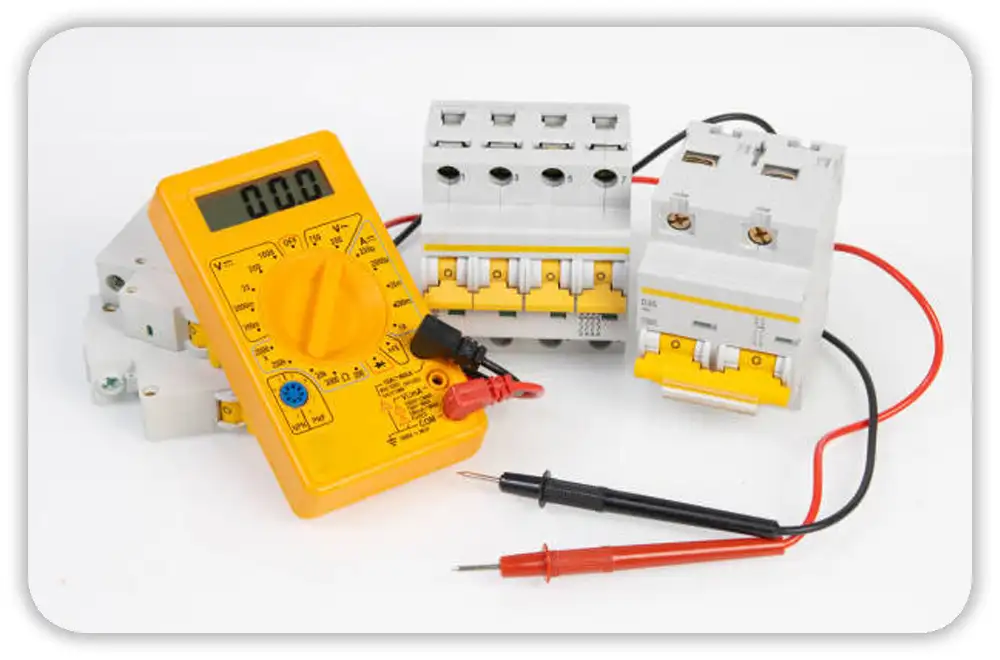It was a chilly Saturday morning in Ohio. The kind where coffee tastes better in the garage. I flipped on my shop lights, and… nothing. Dead quiet. The breaker must’ve tripped again, I thought. But this time, it wouldn’t reset. That’s when I grabbed my multimeter — and learned how to check a circuit breaker the right way.
Table of Contents
Why I Needed to Check My Circuit Breaker
It started as a simple plan — fix a dead outlet. But when every outlet on one wall stopped working, I knew something deeper was off.

When You Know It’s Time to Test
- The breaker trips but won’t reset.
- Power flickers in one room.
- You smell burnt plastic near the panel.
- Or, in my case, your coffee maker quits mid-brew (a tragedy).
I’d seen all these signs before but ignored them. Big mistake.
Tools I Used
Before I even touched the panel, I gathered what I needed. If you’re doing this at home, you don’t need a full electrician kit — just smart basics.
- A digital multimeter (I use a Klein, but any solid brand like Milwaukee or Craftsman works)
- Insulated screwdriver
- Non-contact voltage tester for a quick safety check
- Safety glasses and gloves — because I like my fingers
- Flashlight (the inside of panels are darker than my morning mood before coffee)
In the U.S., most breakers are 120V or 240V, so make sure your multimeter is rated for that range.
Safety First — Electricity Doesn’t Forgive
I’ll be honest — the first time I opened a breaker panel, my heart raced a little. The hum of live electricity is enough to make you respect it fast.

Here’s what I always do before testing anything:
- Stand on a dry surface.
- Keep one hand in my pocket (so current can’t pass through me).
- Never touch the main lugs. Ever.
- Kill the main power if I can.
And if you’re working in humid areas like Florida or the Gulf Coast, dry shoes and gloves are non-negotiable.
How I Checked My Circuit Breaker with a Multimeter
I tested my breaker two ways — once while it was still in the panel and once after pulling it out. Both methods taught me a lot.
Live Test (Breaker Still Installed)
Here’s how I did it:
- Set my multimeter to AC volts (200V range).
- Touched the black probe to the neutral bar.
- Touched the red probe to the breaker screw.
- With the breaker ON, I got a reading around 121V — perfect.
- Turned it OFF — the voltage dropped to 0V.
But if your breaker shows 0V even when ON, that means it’s gone bad.
In my case, another breaker showed nothing — dead. Not even a flicker.
Continuity Test (Breaker Removed)
When I removed the breaker (after cutting main power), I tested it again:
- Switched the multimeter to continuity mode.
- Touched one probe to the line terminal and the other to the load.
- When ON, I should hear a beep — meaning the circuit’s closed.
- When OFF, it should stay silent.
Mine didn’t beep at all. That’s when I knew — this breaker was done for.
What Good vs Bad Looks Like
When a breaker works right, everything feels solid. The switch clicks. The metal’s clean. No weird smells.

But a bad breaker?
- Handle feels loose or spongy.
- No voltage when ON.
- Smells burnt.
- Might even hum a little (yeah, creepy).
One of mine looked perfectly fine but was dead inside. I swapped it for a new Eaton 20A, and boom — lights back on.
Common Mistakes
The first time I tested a live panel, I learned fast what not to do.
- Don’t test continuity with live power. (I blew a meter fuse once — loud pop, small panic.)
- Don’t use both hands inside the panel.
- Don’t forget to disconnect the circuit wire before continuity tests.
- And don’t walk away with the panel open if you’ve got kids or pets around.
Little mistakes can turn big fast.
Final Thoughts from My Garage
After that morning, checking a circuit breaker with a multimeter stopped feeling intimidating. It’s actually simple once you’ve done it a few times.
The best part? Now when my neighbors lose power in one room, I’m the one they call.
I still get that little spark of pride (pun intended) when the multimeter beeps right.
If your breaker’s acting up — don’t guess. Check it. Trust the meter, stay safe, and maybe keep your coffee machine on a different circuit next time.
FAQs about Check Circuit Breaker with Multimeter
How do you check if a circuit breaker is bad with a multimeter?
Set your multimeter to continuity or resistance mode. Touch one probe to the screw terminal and the other to the breaker’s load point. If there’s no reading, the breaker is bad.
Can you test a circuit breaker while it’s still in the panel?
Yes, you can. Set the multimeter to AC voltage, then place one probe on the breaker’s terminal screw and the other on the neutral bar. No voltage means the breaker isn’t passing power.
What should a good circuit breaker read on a multimeter?
A working breaker should show 0 ohms in continuity mode or normal line voltage (around 120V or 240V) when checking with AC voltage mode.
Is it safe to use a multimeter on a live breaker?
Yes—if you follow safety steps. Wear insulated gloves, keep one hand away, and use a multimeter rated for home electrical systems (CAT II or CAT III).

